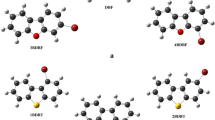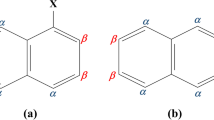Abstract
A series of interatomic interactions interpretable as halogen bonds involving I…I, I…O, and I…C(π), as well as the noncovalent interactions I…H and O…O, were observed in the crystal structures of trans-1,2-diiodoolefins dimers according to ab initio calculations and the quantum theory of “atoms in molecules” (QTAIM) method. The interplay between each type of halogen bond and other noncovalent interactions was studied systematically in terms of bond length, electrostatic potential, and interaction energy, which are calculated via ab initio methods at the B3LYP-D3/6-311++G(d,p) and B3LYP-D3/def2-TZVP levels of theory. Characteristics and nature of the halogen bonds and other noncovalent interactions, including the topological properties of the electron density, the charge transfer, and their strengthening or weakening, were analyzed by means of both QTAIM and “natural bond order” (NBO). These computational methods provide additional insight into observed intermolecular interactions and are utilized to explain the differences seen in the crystal structures.

The contour map presents the regions of electronic concentration and depletion along each bond in one dimer. The blue points denote the BCPs. The blue lines denote positive Laplacian of electron density, which indicate the ionic interactions, van der Waals or intermolecular interactions, and the red lines denote negative Laplacian of electron density which indicate the covalent bonds.







Similar content being viewed by others
References
Shing HP (2017) Halogen bonding in medicinal chemistry: from observation to prediction. Future Med Chem 9:637–640
Wilcken R, Zimmermann MO, Lange A, Joerger AC, Boeckler FM (2013) Principles and applications of halogen bonding in medicinal chemistry and chemical biology. J Mol Model 56:1363–1388
Jungbauer SH, Bulfield D, Kniep F, Lehmann CW, Herdtweck E, Huber SM (2014) Toward molecular recognition: three-point halogen bonding in the solid state and in solution. J Am Chem Soc 136:16740–16743
Parlane FGL, Mustoe C, Kellett CW, Simon SJ, Swords WB, Meyer GJ, Kennepohl P, Berlinguette CP (2017) Spectroscopic detection of halogen bonding resolves dye regeneration in the dye-sensitized solar cell. Nat Commun 8:1761–1768
Priimagi A, Cavallo G, Metrangolo P, Resati G (2013) The halogen bond in the design of functional supramolecular materials: recent advances. Acc Chem Res 46:2686–2695
Metrangolo P, Resnati G, Pilati T (2008) Halogen bonding in crystal engineering. Struct Bond 126:105–136
Raatikainen K, Rissanen K (2012) Breathing molecular crystals: halogen- and hydrogen-bonded porous molecular crystals with solvent induced adaptation of the nanosized channels. Chem Sci 3:1235–1239
Mukherjee A, Tothadi S, Gautam R (2014) Desiraju, Halogen bonds in crystal engineering: like hydrogen bonds yet different. Acc Chem Res 47:2514–2524
Desiraju GR, Ho PS, Kloo L, Legon AC, Marquardt R, Metrangolo P, Politzer P, Resnati G, Rissanen K (2013) Definition of the halogen bond (IUPAC Recommendations 2013). Pure Appl Chem 85:1711–1713
Peter P, Jane SM (2020) Electrostatics and polarization in σ- and π-hole noncovalent interactions: an overview. Chemphyschem 21:579–588
Cavallo G, Metrangolo P, Milani R, Pilati T, Priimagi A, Resnati G, Terraneo G (2016) The halogen bond. Chem Rev 116:2478–2601
Erdelyi M (2012) Halogen bonding in solution. Chem Soc Rev 41:3547–3557
Parisini E, Metrangolo P, Pilati T, Resnati G, Terraneo G (2011) Halogen bonding in halocarbon-protein complexes: a structural survey. Chem Soc Rev 40:2267–2278
Metrangolo, Resnati G (2012) Halogen bonding: where we are and where we are going. Cryst Growth Des 12:5835–5838
Carlsson AC, Gräfenstein J, Budnjo A, Laurila JL, Bergquist J, Karim A, Kleinmaier R, Brath U, Erdélyi M (2012) Symmetric halogen bonding is preferred in solution. J Am Chem Soc 134:5706–5715
Shuman L, Tianlv X, van Mourik T, Früchtl H, Kirk SR, Jenkins S (2019) Halogen and hydrogen bonding in halogenabenzene/NH3 complexes compared using next-generation QTAIM. Molecules 24:2875–2886
Walsh RB, Padgett CW, Metrangolo P (2001) Crsytal engineering through halogen bonding: complexes of nitrogen heterocycles with organic iodides. Cryst Growth Des 1:165–175
Siram RBK, Karothu DP, Row TNG, Patil S (2013) Unique type II halogen···halogen interactions in pentafluorophenyl-appended 2, 2′-bithiazoles. Cryst Growth Des 13:1045–1049
Grabowski SJ (2013) Hydrogen and halogen bonds are ruled by the same mechanisms. Phys Chem Chem Phys 15:7249–7259
Metrangolo P, Resnati G (2008) Halogen versus hydrogen. Science 321:918–919
Cinčić D, Friščić T, Jones W (2011) Experimental and database studies of three-centered halogen bonds with bifurcated acceptors present in molecular crystals, cocrystals and salts. Cyst Eng Comm 13:3224–3231
Politzer P, Murray JS (2013) Halogen bonding: an interim discussion. Chem Phys Chem 14:278–294
Brinck T, Borrfors AN (2019) Electrostatics and polarization determine the strength of the halogen bond: a red card for charge transfer. J Mol Model 25:125–133
Clark T, Murray JS, Politzer P (2018) A perspective on quantum mechanics and chemical concepts in describing noncovalent interactions. Phys Chem Chem Phys 20:30076–30082
Deepa P, Pandiyan BV, Kolandaivel P, Hobza P (2014) Halogen bonds in crystal TTF derivatives: an ab initio quantum mechanical study. Phys Chem Chem Phys 16:2038–2047
Koskinen L, Hirva P, Kalenius E, Jääskeläinen S, Rissanen K, Haukka M (2015) Halogen bonds with coordinative nature: halogen bonding in a S–I+–S iodonium complex. Cryst Eng Comm 17:1231–1236
Bader RFW (1991) A quantum theory of molecular structure and its applications. Chem Rev 91:893–928
Foroutan-Nejad C, Shahbazian S, Marek R (2014) Toward a consistent interpretation of the QTAIM: tortuous link between chemical bonds, interactions, and bond/line paths. Chem Eur J 20:10140–10152
Grimme S, Muck-Lichtenfeld C, Erker G, Kehr G, Wang H, Beckers H, Willner H (2009) When do interacting atoms form a chemical bond? Spectroscopic measurements and theoretical analyses of dideuteriophenanthrene. Angew Chem Int Ed 48:2592–2595
Spackman MA (2015) How reliable are intermolecular interaction energies estimated from topological analysis of experimental electron densities? Cryst Growth Des 15:5624–5628
Politzer P, Murray JS (2019) A looking at bonds and bonding. Struct Chem 30:1153–1157
Clark T, Hennemann M, Murray JS, Politzer P (2007) Halogen bonding: the σ-hole. J Mol Model 13:291–296
Politzer P, Lane P, Concha MC, Ma Y, Murray JS (2007) An overview of halogen bonding. J Mol Model 13:305–311
Zeng Y, Zhang X, Li X, Zheng S, Meng L (2010) Ab initio and AIM studies on typical π-type and pseudo-π-type halogen bonds: comparison with hydrogen bonds. Int J Quantum Chem 111:3725–3740
Zhang X, Zeng Y, Li X, Meng L, Zheng S (2011) A computational study on the nature of the halogen bond between sulfides and dihalogen molecules. Struct Chem 22:567–576
Grabowski SJ (2012) QTAIM characteristics of halogen bond and related interactions. J Phys Chem A 116:1838–1845
Bauzá A, Seth SK, Frontera A (2018) Molecular electrostatic potential and “atoms-in-molecules” analyses of the interplay between π-hole and lone pair···π/X–H···π/metal···π interactions. J Comput Chem 39:458–463
Roselló Y, Benito M, Molins E, Barceló-Oliver M, Frontera A (2019) Adenine as a halogen bond acceptor: a combined experimental and DFT study. Crystals 9:224–233
Wzgarda-Raj K, Rybarczyk-Pirek AJ, Wojtulewski S, Palusiak M (2020) C—Br⋯ S halogen bonds in novel thiourea N-oxide cocrystals: analysis of energetic and QTAIM parameters. Acta Crystallogr C 76:170–176
Domagała M, Lutynska A, Palusiak M (2018) Extremely strong halogen bond. The case of a double-charge-assisted halogen bridge. J Phys Chem A 122:5484–5492
Hettstedt C, Mayer P, Karaghiosoff K (2015) Halogen bonding in the crystal structures of 1,2-diiodo alkenes. New J Chem 39:8522–8533
Weigend F, Ahlrichs R (2005) Balanced basis sets of split valence, triple zeta valence and quadruple zeta valence quality for H to Rn: design and assessment of accuracy. Phys Chem Chem Phys 7:3297–3305
Grimme S, Antony J, Ehrlich S, Krieg H (2010) A consistent and accurate ab initio parametrization of density functional dispersion correction (DFT-D) for the 94 elements H-Pu. J Chem Phys 132:154104–154123
Grimme S, Ehilich S, Goerigk L (2011) Effect of the damping function in dispersion corrected density functional theory. J Comput Chem 32:1456–1465
Frisch MJ, Truchs GW, Schlegel HB, Scuseria GE, Robb MA, Cheeseman JR, Schmani G, Barone V, Mennucci B, Petersson GA, Nakatsuji H, Caricato M, Li X, Hratchian HP, Izmaylov AF, Bloino J, Zheng G, Sonnenberg JL, Hada M, Ehara M, Toyota K, Fukuda R, Hasegawa J, Ishida M, Nakajima T, Honda Y, Kitao O, Nakai H, Vreven T, Montgomery JJA, Peralta JE, Ogliaro F, Bearpark M, Heyd JJ, Brothers E, Kudin KN, Staroverov VN, Kobayashi R, Normand J, Raghavachari K, Rendell A, Burant JC, Iyengar SS, Tomasi J, Cossi M, Rega N, Millam NJ, Klene M, Knox JE, Cross JB, Bakken V, Adamo C, Jaramillo J, Gomperts R, Stratmann RE, Yazyev O, Austin AJ, Cammi R, Pomelli C, Ochterski JW, Martin RL, Morokuma K, Zakrzewski VG, Voth GA, Salvador P, Dannenberg JJ, Dapprich S, Daniels AD, Farkas Ö, Foresman JB, Ortiz JV, Cioslowski J, Fox DJ (2015) Gaussian 09, Revision E.01. Gaussian, Inc., Wallingford, CT
Zhao H, Chang J, Du L (2016) Effect of hydrogen bonding on the spectroscopic properties of molecular complexes with aromatic rings as acceptors. Comput Theor Chem 1084:126–132
Zhang Q, Du L (2016) Hydrogen bonding in the carboxylic acid–aldehyde complexes. Comput Theor Chem 1078:123–128
Tang S, Zhao H, Du L (2016) Hydrogen bonding in alcohol–ethylene oxide and alcohol–ethylene sulfide complexes. RSC Adv 6:91233–91242
Bauzá A, Quinonero D, Deya PM, Frontera A (2013) Halogen bonding versus chalcogen and pnicogen bonding: a combined Cambridge structural database and theoretical study. Cryst Eng Comm 15:3137–3144
Kolář M, Hostaš J, Hobza P (2014) The strength and directionality of a halogen bond are co-determined by the magnitude and size of the σ-hole. Phys Chem Chem Phys 16:9987–9996
Bauzá A, Ramis R, Frontera A (2014) Computational study of anion recognition based on tetrel and hydrogen bonding interaction by calix[4]pyrrole derivatives. Comput Theor Chem 1038:67–70
Boys SF, Bernardi F (1970) The calculation of small molecular interactions by the differences of separate total energies. Some procedures with reduced errors. Mol Phys 19:553–566
Bader RFW, Carroll MT, Cheeseman JR, Cheng C (1987) Properties of atoms in molecules: atomic volumes. J Am Chem Soc 109:7968–7979
Glendening ED, Reed AE, Carpenter JE, Weinhold F (1990) NBO 3.1, QCPE Bull 1990, 10, 58
Keith TA (2011) AIMAll, 15.09.27, TK Gristmill Software
Zordan F, Brammer L, Sherwood P (2005) Supramolecular chemistry of halogens: complementary features of inorganic (M− X) and organic (C− X ‘) halogens applied to M− X...X ‘− C halogen bond formation. J Am Chem Soc 127:5979–5989
Domagała M, Matczak P, Palusiak M (2012) Halogen bond, hydrogen bond and N⋯ C interaction–on interrelation among these three noncovalent interactions. Comput Theor Chem 998:26–33
Domagała M, Palusiak M (2014) The influence of substituent effect on noncovalent interactions in ternary complexes stabilized by hydrogen-bonding and halogen-bonding. Comput Theor Chem 1027:173–178
Domagała M, Lutyńska A, Palusiak M (2017) Halogen bond versus hydrogen bond: the many-body interactions approach. Int J Quantum Chem 117:e25348–e25356
Popelier PLA (2000) Atoms in molecules: an introduction. Prentice Hall, Pearson Education Limited, New York
Rozas I, Alkorta I, Elguero J (2000) Behaviour of ylides containing N, O and C atoms as hydrogen bond acceptors. J Am Chem Soc 122:11154–11161
Funding
This work was supported by the Fundamental Research Funds for the Central Universities (Grant No. lzujbky-2019-cd05), the National Natural Science Foundation of China (No. 81973786), and the Science Foundation of Guangxi (AA17204096, AD16380076).
Author information
Authors and Affiliations
Corresponding author
Additional information
Publisher’s note
Springer Nature remains neutral with regard to jurisdictional claims in published maps and institutional affiliations.
Supplementary Information
ESM 1
(DOCX 17 kb)
Rights and permissions
About this article
Cite this article
Yuan, Y., Mills, M.J.L., Li, F. et al. Halogen bonds and other noncovalent interactions in the crystal structures of trans-1,2-diiodo alkenes: an ab initio and QTAIM study. J Mol Model 26, 331 (2020). https://doi.org/10.1007/s00894-020-04591-2
Received:
Accepted:
Published:
DOI: https://doi.org/10.1007/s00894-020-04591-2




